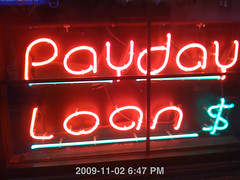- RT @Dave_Champion Obama asks DOJ to look at whether AZ immigration law is constitutional. Odd that he never did that with #Healthcare #tcot #
- RT @wilw: You know, kids, when I was your age, the internet was 80 columns wide and built entirely out of text. #
- RT @BudgetsAreSexy: RT @FinanciallyPoor "The real measure of your wealth is how much you'd be worth if you lost all your money." ~ Unknown #
- Official review of the double-down: Unimpressive. Not enough bacon and soggy breading on the chicken. #
- @FARNOOSH Try Ubertwitter. I haven't found a reason to complain. in reply to FARNOOSH #
- Personal inbox zero! #
- Work email inbox zero! #
- StepUp3D: Lame dancing flick using VomitCam instead or choreography. #
- I approve of the Nightmare remake. #Krueger #
The Magic Toilet

- Image by tokyofortwo via Flickr
My toilet is saving me $1200.
For a long time, my toilet ran. It was a nearly steady stream of money slipping down the drain. I knew that replacing the flapper was a quick job, but it was easy to ignore. If I wasn’t in the bathroom, I couldn’t hear it. If I was in the bathroom, I was otherwise occupied.
When I finally got sick of it, I started researching how to fix a running toilet because I had never done it before. I found the HydroRight Dual-Flush Converter. It’s the magical push-button, two-stage flusher. Yes, science fiction has taken over my bathroom. Or at least my toilet.
I bought the dual-flush converter, which replaces the flusher and the flapper. It has two buttons, which each use different amounts of water, depending on what you need it to do. I’m sure there’s a poop joke in there somewhere, but I’m pretending to have too much class to make it.
I also bought the matching fill valve. This lets you set how much water is allowed into the tank much better than just putting a brick in the tank. It’s a much faster fill and has a pressure nozzle that lies on the bottom of the tank. Every time you flush, it cleans the inside of the tank. Before I put it in, it had been at least 5 years since I had opened the tank. It was black. Two weeks later, it was white again. I wouldn’t want to eat off of it, or drink the water, but it was a definite improvement.
Installation would have been easier if the calcium buildup hadn’t welded the flush handle to the tank. That’s what reciprocating saws are for, though. That, and scaring my wife with the idea of replacing the toilet. Once the handle was off, it took 15 minutes to install.
“Wow”, you say? “Where’s the $1200”, you say? We’ve had this setup, which cost $35.42, since June 8th, 2010. It’s now September. That’s summer. We’ve watered both the lawn and the garden and our quarterly water bill has gone down $30, almost paying for the poo-gadget already. $30 X 4 = $120 per year, or $1200 over 10 years.
Yes, it will take a decade, but my toilet is saving me $1200.
Charity is Selfish
I try to give 10% of my income to charity. I don’t succeed every year, but I do try.
I don’t give because I’m generous. I give because I’m selfish.
If you give to charity, you are too.
I’m not talking about people who give to charity strictly for the tax deduction, though that is selfish too. I’m referring specifically to the people who give to charity out of the goodness of their hearts.
If I give a thousand dollars worth of clothes to a homeless shelter, I get a warm fuzzy feeling knowing that I helped people stay warm.
If I send $100 to the Red Cross for whatever terrible disaster happened shortly before I made the donation, it makes me feel good to have contributed to saving those lives.
The put-the-inner-city-kids-on-a-horse thing we do? Makes me happy to get those kids into a positive situation.
Donating blood? Yay, me! I’m saving lives!
While it’s nice to help other people, that’s not the ultimate reason I’m doing it. I do it because it makes me feel good about myself to help other people, particularly people who–for whatever reason–can’t help themselves.
That’s the basis of altruism. It’s not about helping others, it’s about feeling good about helping others.
The truly selfish, the evil dogooders, are the ones who want to raise taxes to give it away as “charity”. They get to feel like they are doing something and helping others while not actually contributing themselves and, at the same time, stealing that warm fuzzy feeling from the people who are providing the money to start with.
Evil.
Charity has to be done at a personal, local level or the benefits to the giver are eliminated while the benefits to the receiver are lessened. Bureaucracy doesn’t create efficiency.
For the record, if it’s taken by force, by tax, it isn’t charity. Charity cannot be forced. Forcing charity is, at best, a fraudulent way for petty politicians, bureaucrats, lobbyists, and activists to feel they have power over others.
Again, evil.
How to Prioritize Your Spending
Don’t buy that.
At least take a few moments to decide if it’s really worth buying.
Too often, people go on auto-pilot and buy whatever catches their attention for a few moments. The end-caps at the store? Oh, boy, that’s impossible to resist. Everybody needs a 1000 pack of ShamWow’s, right? Who could live without a extra pair of kevlar boxer shorts?
Before you put the new tchotke in your cart, ask yourself some questions to see if it’s worth getting.
1. Is it a need or a want? Is this something you could live without? Some things are necessary. Soap, shampoo, and food are essentials. You have to buy those. Other things, like movies, most of the clothes people buy, or electronic gadgets are almost always optional. If you don’t need it, it may be a good idea to leave it in the store.
2. Does it serve a purpose? I bought a vase once that I thought was pretty and could hold candy or something, but it’s done nothing but collect dust in the meantime. It’s purpose is nothing more than hiding part of a flat surface. Useless.
3. Will you actually use it? A few years ago, my wife an cleaned out her mother’s house. She’s a hoarder. We found at least 50 shopping bags full of clothes with the tags still attached. I know, you’re thinking that you’d never do that, because you’re not a hoarder, but people do it all the time. Have you ever bought a book that you haven’t gotten around to reading, or a movie that went on the shelf, still wrapped in plastic? Do you own a treadmill that’s only being used to hang clothes, or a home liposuction machine that is not being used to make soap?
3. Is it a fad? Beanie babies, iPads, BetaMax, and bike helmets. All garbage that takes the world by storm for a few years then fades, leaving the distributors rich and the customers embarrassed.
4. Is it something you’re considering just to keep up with the Joneses? If you’re only buying it to compete with your neighbors, don’t buy it. You don’t need a Lexus, a Rolex, or that replacement kidney. Just put it back on the shelf and go home with your money. Chances are, your neighbors are only buying stuff so they can compete with you. It’s a vicious cycle. Break it.
5. Do you really, really want it? Sometimes, no matter how worthless something might be, whether it’s a fad, or a dust-collecting knick-knack, or an outfit you’ll never wear, you just want it more than you want your next breath of air. That’s ok. A bit disturbing, but ok. If you are meeting all of your other needs, it’s fine to indulge yourself on occasion.
How do you prioritize spending if you’re thinking about buying something questionable?
Why I Hate Payday Loans
I hate payday loans and payday lenders.
The way a way a payday loan works is that you go into a payday lender and you sign a check for the amount you want to borrow, plus their fee. They give you money that you don’t have to pay back until payday. It’s generally a two-week loan.
Now, this two week loan comes with a fee, so if you want to borrow $100, they’ll charge you a $25 fee, plus a percent of the total loan, so for that $100 loan, you’ll have to pay back $128.28.
That’s only 28% of actual interest; that’s not terrible. However, if you prorate that to figure the APR, which is what everyone means when they say “I’ve got a 7% interest rate”, it comes out to 737%. That’s nuts.
They are a very bad financial plan.
Those loans may save you from an overdraft fee, but they’ll cost almost as much as an overdraft fee, and the way they are rigged–with high fees, due on payday–you’re more likely to need another one soon. They are structured to keep you from ever getting out from under the payday loan cycle.
For those reasons, I consider payday loan companies to be slimy. Look at any of their sites. Almost none are upfront about the total cost of the loan.
So I don’t take their ads. When an advertiser contacts me, my rate sheet says very clealy that I will not take payday loan ads. The reason for that is–in my mind–when I accept an advertiser, I am–in some form–endorsing that company, or at least, I am agreeing that they are a legitimate business and I am helping them conduct that business.
In all of the time I’ve been taking ads, I’ve made exactly one exception to that rule. On the front page of that advertiser’s website, they had the prorated APR in bright, bold red letters. It was still a really bad deal, but with that level of disclosure, I felt comfortable that nobody would click through and sign up without knowing what they were getting into. That was a payday lender with integrity, as oxymoronic as that sounds.
Comfort Zone
Even though some people disagree, I am an introvert.

Crowds, strangers, and activities I don’t understand are all things that make me uncomfortable.
A couple of weeks ago, my business partner forwarded an invitation to me. One of our clients invited us to his annual “Giant-Ass Poker Tournament.”
I haven’t played more than a hand or two of poker in more than 20 years. If you do the math, that’s junior high school or earlier. I’ve never played Texas Hold ‘Em at all. Thirty to forty people were expected to be there.
Crowds? Check.
Strangers? Check.
An activity I don’t understand? Check.
I was planning to blow it off. My partner could handle the social niceties, I could stay home and watch Dexter. Win/win.
Saturday, I got a text telling me that our client wants to talk business at the tournament.
Cue four letter words.
I tried to get out of it. I tried to play sick. My partner–also my best friend and designated extrovert–wouldn’t hear of it.
So I walk into this tournament full of people I don’t know. I was late. I thought that would make a good compromise. I’ll deal with the crowd, and ignore the activity I don’t understand.
First words out of the client’s mouth? “Jason! Great to see you, we just started, so let’s buy you in!”
Crap.
I sat out the first game, and talked the business that needed to be talked. Mission accomplished.
Half an hour into it, my friend sends me a text telling me to do a quick wiki search.
Teach myself to play poker using wikipedia while watching a $50 buy-in game played by experienced players? That’s effen nuts.
I knew the hands, I was already familiar with the bet/call/raise process in general. I was really just missing a few details and the mechanics of Hold ‘Em.
What the hell, it’s only $50.
I went out to the living room/bar area and pulled up wikipedia. After reading everything I could, plus a few terms that had never previously registered (A check isn’t what happens when you bet more than you have. Who knew?), I went back to the game and watched with a bit of understanding about what I was seeing.
When the second game started, I bought in and played until almost 2AM. I had a great time and went home $150 richer than I arrived.
Leaving your comfort zone is, by definition, uncomfortable. Sometimes, it’s downright painful. Without it, you can’t grow as a person. Find yourself someone who is willing to obnoxiously drag you into situations that push your limits. It really can be fun.





